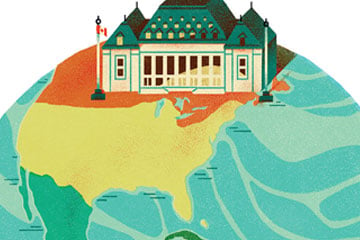Top courts in other countries play very different roles than Canada’s Supreme Court. As democracy falters, top courts, sometimes reluctantly, sometimes eagerly, take on political and policy roles previously the prerogative of elected officials. Professors of political science sometimes call this process “countermajoritarianism.” (Only academics could dream up such a hideous word.)

As democracy falters, top courts, sometimes reluctantly, sometimes eagerly, take on political and policy roles previously the prerogative of elected officials. Professors of political science sometimes call this process “countermajoritarianism.” (Only academics could dream up such a hideous word.)
The dance of the judiciary with other branches of government is complex, delicate and varied. Sometimes, judges, in good faith, seek to offset misdeeds by the executive branch.
Sometimes, they seek to promote a political agenda that differs from the agenda of the elected government. Sometimes, in the most egregious instances, they act as the mindless lap dogs of powerful rulers.
For starters, consider South Africa, a country where the courts struggle to curb abuses by elected officials, particularly those of President Jacob Zuma and his henchmen. The Economist noted last November that “an unexpected by-product of Mr. Zuma’s scandal-plagued presidency has been a growing public interest in the justice system . . . ” The judiciary, said the newspaper, had acted “as a bulwark for South African democracy at a time when other institutions, including the police and state prosecutors, have been compromised.” My friend Lourens Ackermann, a leading Cape Town barrister, remarked to me the other day, “The courts of South Africa have been magnificent.” But there are dangers in this magnificence. The Economist warned, quite rightly, that activist judges in South Africa — even those acting out of the best possible motives — become increasingly vulnerable to political attack.
There are similarities between South Africa and Brazil. Brazil’s highest court, the Supreme Federal Court (the Supremo Tribunal Federal or STF), has the constitutional power to try members of parliament or government ministers who otherwise have immunity from prosecution. In a corruption-ridden country (think Petrobras scandal), prosecuting members of parliament and government ministers have given the STF a prominent political role. But, again, there are temptations and risks. The Economist comments, “Justices speak too much in public, often rashly. Live broadcasts of STF sessions amplify large egos.”
Good on the courts of South Africa and Brazil for doing what they can to keep their governments on the straight and narrow. Bad things would happen if they failed to act. But behaving in this way is not without cost. Activist judges can lose stature and credibility in the eyes of the public. They may come to be seen as just another group of politicians seeking power and privilege. If judges get dragged too far into the political and policy arena, they may become sullied and compromised. Their credibility as impartial arbiters may evaporate.
For many years, the Supreme Court of Israel was an example of a top court promoting a separate political agenda. Starting in the 1990s, then president (chief justice) of the court, Aharon Barak, led what he called a “constitutional revolution,” promoting liberalism in a country that, as it happens, was growing more conservative all the time. A New York Times op-ed piece observed, “As liberals lost elections, they increasingly turned to the courts . . . judges became a constant irritant to the conservatives who won elections only to see their agendas constrained by the judiciary.” But that’s all history now. Recent conservative appointments to Israel’s High Court have brought Barak’s constitutional revolution to an end. (Barak himself retired in 2006.) Says The New York Times, “Now the right has the opportunity to prove that it can run the country effectively without being fettered by a liberal court.”
Venezuela’s Supreme Court fits into the despised lap dog category. A March 30 article in The New York Times began this way: “Venezuela took its strongest step yet toward one-man rule under the leftist President Nicolás Maduro as his loyalists on the Supreme Court seized power from the National Assembly in a ruling late Wednesday night. The ruling effectively dissolved the elected legislature. . . and allows the court to write laws itself . . . ” Faced with widespread outrage, both domestic and international, the court, at the request of Maduro, backed down a few days later and reversed its ruling. There is deep suspicion of Maduro’s strategy. What’s he up to? The country remains in chaos. The judiciary is totally discredited. The Supreme Court of Venezuela deserves only contempt.
So, what about Canada? What kind of dance does our top court have with the executive and legislative branches of government? Sarabande? Waltz? Polka?
One thing’s for sure, the Supreme Court of Canada has nothing in common with the despised Supreme Court of Venezuela. Nor does it chase all over the country looking for political miscreants, like Brazil’s STF. But, sometimes, it does look like a muted version of the Constitutional Court of South Africa, or Israel’s Supreme Court, flexing policy muscles to the dismay of the executive branch.
The resemblance to South Africa is no surprise. The South African constitution is similar in important respects to the Canadian constitution (Canadian advisers had a hand in drafting the South African constitution, particularly the Bill of Rights). The South African Constitutional Court often refers to Canadian jurisprudence. The two courts are sister courts. As for Israel, the similarities are slightly more sinister. When he was prime minister, Stephen Harper was known to have commiserated with his friend Prime Minister Bibi Netanyahu over the way supreme courts like to flex their muscles. Harper, you may remember, had issues with the Supreme Court of Canada. The court was not always compliant with his wishes, despite being top-heavy with his appointees. He even went as far as publicly criticizing Chief Justice Beverley McLachlin, an event that caused quite a sensation in our quiet and peaceable land, at least in certain circles (although that largely manufactured controversy was only a tempest in a teapot).
I think that the Supreme Court of Canada has got it just about right, independently contributing to justice and democracy, while avoiding hubris and exercising restraint. Compared to many other top courts, it looks pretty good.
Philip Slayton is working on a new book about freedom in Canada.








